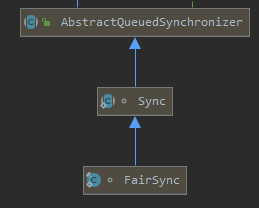源码中的设计模式-模板方法模式
今天看AQS时,注意到它用到了模板方法设计模式。模板设计模式比较简单,父类定义好操作骨架,将一些方法的实现延迟到子类中,让子类实现。子类继承父类,实现必要的方法但不改变操作流程的整体结构。模板方法属于行为设计模式。
AQS提供的模板方法如下:
// 独占式获取同步状态
@Override
protected boolean tryAcquire(int arg) {
return super.tryAcquire(arg);
}
// 独占式释放同步状态
@Override
protected boolean tryRelease(int arg) {
return super.tryRelease(arg);
}
// 共享式获取同步状态
@Override
protected boolean tryReleaseShared(int arg) {
return super.tryReleaseShared(arg);
}
// 共享式释放同步状态
@Override
protected int tryAcquireShared(int arg) {
return super.tryAcquireShared(arg);
}
// 当前同步器是否是在独占式模式被线程占用,一般表示是否被当前线程所占
@Override
protected boolean isHeldExclusively() {
return super.isHeldExclusively();
}
ReentrantLock中的抽象静态内部类Sync实现了AQS中的tryRelease和isHeldExclusively模板方法,而实现非公平锁以及公平锁的类NonfairSync 和 FairSync 又继承了父类Sync,实现了tryAcquire方法。部分代码如下:

public class ReentrantLock implements Lock, java.io.Serializable { private static final long serialVersionUID = 7373984872572414699L; /** Synchronizer providing all implementation mechanics */ private final Sync sync; /** * Base of synchronization control for this lock. Subclassed * into fair and nonfair versions below. Uses AQS state to * represent the number of holds on the lock. */ abstract static class Sync extends AbstractQueuedSynchronizer { private static final long serialVersionUID = -5179523762034025860L; /** * Performs {@link Lock#lock}. The main reason for subclassing * is to allow fast path for nonfair version. */ abstract void lock(); /** * Performs non-fair tryLock. tryAcquire is implemented in * subclasses, but both need nonfair try for trylock method. */ final boolean nonfairTryAcquire(int acquires) { final Thread current = Thread.currentThread(); int c = getState(); if (c == 0) { if (compareAndSetState(0, acquires)) { setExclusiveOwnerThread(current); return true; } } else if (current == getExclusiveOwnerThread()) { int nextc = c + acquires; if (nextc < 0) // overflow throw new Error("Maximum lock count exceeded"); setState(nextc); return true; } return false; } protected final boolean tryRelease(int releases) { int c = getState() - releases; if (Thread.currentThread() != getExclusiveOwnerThread()) throw new IllegalMonitorStateException(); boolean free = false; if (c == 0) { free = true; setExclusiveOwnerThread(null); } setState(c); return free; } protected final boolean isHeldExclusively() { // While we must in general read state before owner, // we don't need to do so to check if current thread is owner return getExclusiveOwnerThread() == Thread.currentThread(); } final ConditionObject newCondition() { return new ConditionObject(); } // Methods relayed from outer class final Thread getOwner() { return getState() == 0 ? null : getExclusiveOwnerThread(); } final int getHoldCount() { return isHeldExclusively() ? getState() : 0; } final boolean isLocked() { return getState() != 0; } /** * Reconstitutes the instance from a stream (that is, deserializes it). */ private void readObject(java.io.ObjectInputStream s) throws java.io.IOException, ClassNotFoundException { s.defaultReadObject(); setState(0); // reset to unlocked state } } /** * Sync object for non-fair locks */ static final class NonfairSync extends Sync { private static final long serialVersionUID = 7316153563782823691L; /** * Performs lock. Try immediate barge, backing up to normal * acquire on failure. */ final void lock() { if (compareAndSetState(0, 1)) setExclusiveOwnerThread(Thread.currentThread()); else acquire(1); } protected final boolean tryAcquire(int acquires) { return nonfairTryAcquire(acquires); } } /** * Sync object for fair locks */ static final class FairSync extends Sync { private static final long serialVersionUID = -3000897897090466540L; final void lock() { acquire(1); } /** * Fair version of tryAcquire. Don't grant access unless * recursive call or no waiters or is first. */ protected final boolean tryAcquire(int acquires) { final Thread current = Thread.currentThread(); int c = getState(); if (c == 0) { if (!hasQueuedPredecessors() && compareAndSetState(0, acquires)) { setExclusiveOwnerThread(current); return true; } } else if (current == getExclusiveOwnerThread()) { int nextc = c + acquires; if (nextc < 0) throw new Error("Maximum lock count exceeded"); setState(nextc); return true; } return false; } } .... }
公平锁有以下继承关系,非公平锁类似:

收住自己的心 一步一个脚印 做好自己的事




 浙公网安备 33010602011771号
浙公网安备 33010602011771号